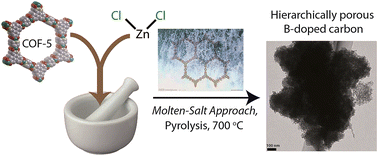From covalent–organic frameworks to hierarchically porous B-doped carbons: a molten-salt approach†
Abstract
B-doped porous carbons have attracted attention in energy applications including gas and energy storage due to the increase of binding energy for H2 and lowering the Fermi level. However, B-doped carbons are usually microporous materials, which show low surface areas. Herein, for the first time, hierarchically porous B-doped carbons derived from COF-5 have been obtained via a molten-salt (MS) approach. The carbons with micro–meso–macro-porous architectures exhibit enhanced supercapacitive performance and H2 storage properties. The methodology described may open up a new avenue towards the synthesis of distinct carbon materials in liquid media.


 Please wait while we load your content...
Please wait while we load your content...